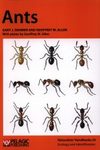Field / Identification Guide Identification Key
By: Oliver E Prys-Jones(Author), Sarah A Corbet(Author)
138 pages, 4 col plates, b/w illus, figs, tabs, dist maps
Indispensable guide to identification, ecology and study of bumblebees; "...it really is THE book on bumblebees that you need whether you are an expert or a novice"
![Bumblebees Bumblebees]()
Click to have a closer look
About this book
Contents
Customer reviews
Biography
Related titles
About this book
This new edition embraces the wealth of information published on bumblebee life history, ecology, foraging, parasites and conservation in recent years. It includes a new chapter on the very real threats to bumblebees; their crucial role as pollinators of our native flora and crops; ways to promote their survival; advantages and problems posed by their commercial use; as well as updated colour plates, keys and distribution maps of all British species (including Bombus hypnorum). The book introduces techniques and approaches to original work so that anyone with an interest can usefully contribute to furthering our understanding and appreciation of these wonderful and important insects.
Contents
Preface to the third edition
Acknowledgements
Foreword
Introduction
Distribution and recognition
The natural history of true bumblebees (Bombus)
Nests and their establishment in captivity
Cuckoo bumblebees Bombus (Psithyrus), parasites and nest associates
Foraging behaviour
Threats, conservation and commercial use
Identification
-Chart A. Is the specimen a true bumblebee, or a cuckoo bumblebee, or neither?
-Quick-Check Key to common species
-Main keys
-I: Female true bumblebees Bombus
-II: Male true bumblebees Bombus
-III: Female cuckoo bumblebees Bombus (Psithyrus)
-IV: Male cuckoo bumblebees Bombus (Psithyrus)
Approaches to original work: techniques and web resources
Further reading and references
Synonymy
Index
Distribution maps
Customer Reviews
Biography
Oliver E Prys-Jones studied zoology at the University of St. Andrews and furthered a long term interest in bumblebees and their life histories with doctoral and research fellowship studies at the University of Cambridge. He subsequently qualified in medicine at Liverpool University and remains absorbed by bumblebees while working as a medical practitioner in North Wales.
Sarah A Corbet has taught entomology and ecology in London University and the University of Cambridge. Her research interest is in pollination ecology, with a special focus on bumblebees.
Field / Identification Guide Identification Key
By: Oliver E Prys-Jones(Author), Sarah A Corbet(Author)
138 pages, 4 col plates, b/w illus, figs, tabs, dist maps
Indispensable guide to identification, ecology and study of bumblebees; "...it really is THE book on bumblebees that you need whether you are an expert or a novice"
If you've never looked at a Naturalists' Handbook then you're missing a treat. The 29 books in the series, primarily on various British insect groups, are designed to provide the amateur investigator with everything they need to know to make their own original contributions to science. The series was originally published by Cambridge University Press, then Richmond and the Company of Biologists, gradually going into decline until revitalised by Pelagic Publishing. One of the first books they've produced is this third edition of Bumblebees. Even if you've no professional interest in these furry little things, have you ever sat in the garden and wondered what they're up to? In 130 pages you are led through their natural history, foraging behaviour, uses to humans and their conservation problems in very simple (but far from simplistic) language, concentrating on the 6 common species (out of our current 24) and the 6 parasitic 'cuckoo' bumblebees. Uniquely, there is also a chapter on raising them all in captivity for study. To do this, you need to know which species is which and there is a lovely chapter on identification with keys, notes on the bits of morphology that help, distribution maps and a particularly useful 'Quick-check key' to the commoner species based mainly on thorax and 'tail' colour - even I could make it work in a few minutes in the garden. This is backed up by the high quality colour plates with drawings of each species that are a superb feature of these handbooks. The final chapter gives suggestions for independent study from sampling stomach contents to looking at the pollen they carry to recording distributions. A wonderful book to read, use and enjoy; and top marks to Pelagic Publishing for revitalising this invaluable series.
- Peter Thomas, The Bulletin Dec 2011, British Ecological Society
"The newly released 3rd edition of 'Bumblebees', number 6 of the Naturalists Handbooks series for ecology and identification by Pelagic Publishing, is a phenomenal resource. Focused on British bumblebees, this book is full of information about all aspects of the ecology of bumblebees which makes it a valuable resource for readers in any location. It s a book which is not overburdened with too much scientific data (although much is referenced), but still packs in a great deal of information, this book is very useful. I recently researched bumblebees for an Urban Species Profile and I wish I'd had this book then because it contains all of the information I had to gather from many different resources." - Kelly Brenner at The Metropolitan Field Guide
"...it really is THE book on bumblebees that you need whether you are an expert or a novice"
- Mark Avery
"Having informed and taught the reader with much skillfully packaged knowledge the remainder of the book goes into greater detail on identification and even points the way to approaches for original work. Backing up these pointers with an exhaustive list of web resources and further reading. An essential book for anyone who has enjoyed the sight and sound of a bumblebee in their garden."
- Bee World, Sept. 2011
















































